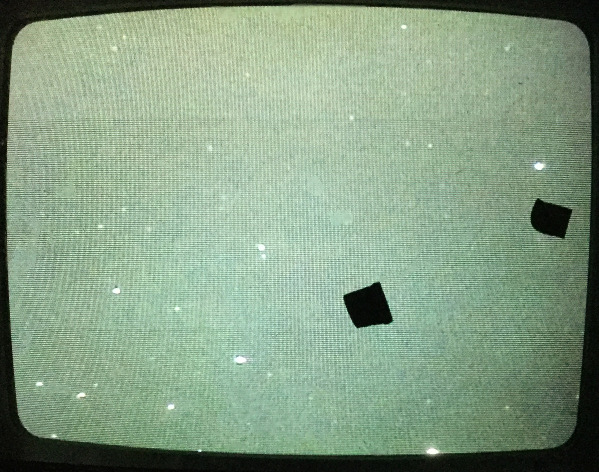
On the night of Jun 13/14, 2020, under good conditions, I acquired images for astrometry of two nearby stars. One was Ross 248 , and the other GX And ; the latter is actually a double star, with two components separated by about 35 arcsec moving together.
The positions of Ross 248 are still consistent with "no motion over the past month," but that's actually expected. I'm finally starting to see some of GX And's proper motion in RA, which is nice.
This is one of the stars that a capstone student may study over the next year in a project involving parallax. Ross 248 is a relatively faint red star surrounded by many other stars of similar brightness, so it's a good candidate for high-precision parallax measurements.
The main setup was:
Notes from the night:
The object is (currently) near position
RA = 23:41:55.27 Dec = +44:10:06.38 (J2000)
A chart of the field is shown below. The size of the chart is about 41 x 27 arcminutes. The noisy area at right (West) is the shadow of the guider's pickoff mirror.

I've marked the location of several comparison stars.
star UCAC4 B V r ------------------------------------------------------------------------- A UCAC4 671-120730 12.617 10.689 B UCAC4 671-120688 C UCAC4 671-120749 10.987 10.663 P kappa And 4.06 4.14 --------------------------------------------------------------------------
I took a photo of the finder TV's screen when pointing to Ross 248; this could be a useful reference for the future:

I ran the camera at -20 C. Nothing out of the ordinary.

I took one series of 50 exposures of the field, using the R-band filter and an exposure time of 20 seconds.
Using the same techniques as described for earlier nights, I matched detected stellar positions to the Gaia DR2 catalog; as usual, I used a linear model and included all stars in the catalog.
This is my fourth (post-collimation) measurement of Ross 248; the graph below shows the positions from the first night (red), second (green), third (blue), and this night (cyan). Basically, no significant motion -- but since Ross 248 is close to quadrature, it turns out the expected motion is too small to measure so far.

Like Ross 248, GX And is a nearby (binary) star which will be the target of a parallax project in the coming year. One of the two components is bright -- about mag V = 8 -- so one must use short exposures to prevent it from saturating the detector. That may mean that this system isn't as easy to measure as Ross 248 or some others.
The object is currently close to this position:
RA = 00:18:28.4 Dec = +44:01:31 (J2000)
but it does have a very high proper motion.
A chart of the field is shown below. The size of the chart is about 41 x 27 arcminutes. The noisy area at right (West) is the shadow of the guider's pickoff mirror.

The two components of the GX And binary sit inside the box. I've marked the location of several comparison stars as well.
star UCAC4 B V r ----------------------------------------------------------- A 671-001473 9.939 9.790 B 670-001639 9.413 8.472 C 671-001509 12.712 11.421 11.001 -----------------------------------------------------------
I took a photo of the finder TV's screen when pointing to GX And; this could be a useful reference for the future:

I took a series of 100 exposures of the field, using the R-band filter and an exposure time of only 5 seconds. The field was at an altitude of about 47 degrees.
Using the same techniques as described for earlier nights, I matched detected stellar positions to the Gaia DR2 catalog.
This is my fourth (post-collimation) measurement of GX And, and at last we see some motion in RA; the proper motion of GX And is very large (2891 mas/yr).

I also took pictures of Jupiter and Saturn, just for fun, as they are crossing the meridian at dawn. The appropriate exposure times in the R-band band, when binned 2x2, are
I tried taking over one hundred pictures of each, so that I could try some lucky-imaging processing using AutoStakkert , but I discovered that this mode of imaging just doesn't work well for planets: the image scale of 1.25 arcsec per pixel doesn't provide samples across the tiny disks of the planets.
Below you can see a single image of each planet: on the left with a soft stretch to show moons, and on the right with a hard stretch to show detail on the planet's cloudtops.
Jupiter's two visible moons are Europa on the left (East) and Ganymede on the left (West). Io should just start peeking out from the western limb of the planet during my observations, but this one was early in the sequence.

Saturn's two visible moons are Titan above (North), and Rhea to the left (East). Rhea, at mag V=10.4, is barely visible. In some of the images, one can imagine seeing Tethys (mag 10.9) at about 1:30 relative to the planet, just beyond the rings.

Last modified 6/14/2020 by MWR.